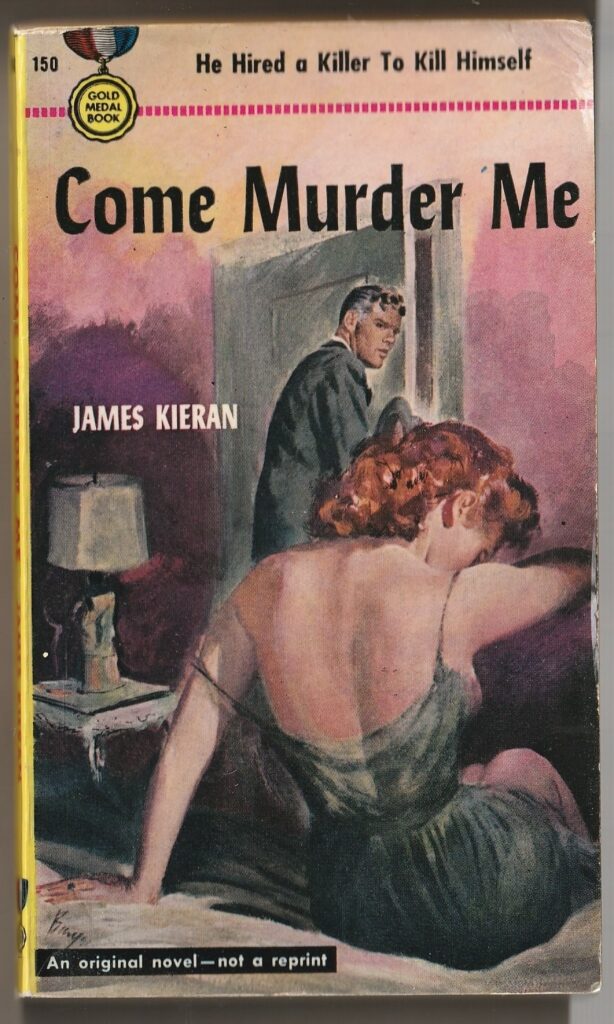The paperback novel Come Murder Me by James Kieran was published in March, 1951, and Kieran died ten months later at the age of 50.
It was a Gold Medal Original which means the book had not already appeared as a hardcover. I found it, with its come-hither cover of a redhead showing a lot of skin, in one of those free book boxes that populate my area of Chicago.
On the cover, above the title, was the readout: “He Hired a Killer to Kill Himself.” And that pretty much summed up the story.
On the back were the words: “Murder waited for him in the hall. The girl on the bed wanted him to stay. But he strode to the door, opened it! WHY?” Oddly, there is no scene like this in the book that I recall, but such was paperback publishing in mid-twentieth century America.
The cover, no surprise, wasn’t all that true to the book either. The guy who is shown has graying hair and seems to be in his forties. The main character Curt Jackson, however, is 29 and sports a crew-cut.
I pick up a lot of books at those free little libraries and return most of them without reading. But, in doing a little internet research, I’d come across the fact that Kieran died shortly after publishing this, his first novel. And I had the sentimental notion that I’d read it to see what the world might have lost due to his early death.
The answer: Not much, at least, in terms of book-writing.
A mess

Come Murder Me is a mess.
The core idea — a guy who, because of a head wound in the war, discovers he has a split personality — has a great deal of potential. Jackson’s alter ego is Arthur Brownlow, and, while Jackson is a successful architect, Brownlow is something of a low-life.
AND Brownlow hates Jackson — I guess, hates the fact that Jackson exists — so much that he pays some professional killers to, well, kill him.
HOWEVER, I never could get my head around the fact that Brownlow had to know that, when the killers killed Jackson, that they would also be killing Brownlow. Duh!
I guess the reader was expected to think that mental illness or, at least, mental confusion was enough to block Brownlow’s desire for self-preservation.
Cabs, hotels, drinking, etc.
The story is set mainly in New York City, and there’s a lot of getting into and out of taxis in Come Murder Me, and a lot of people getting rooms in hotels only to then need to get a room at another hotel.
There are Army buddies, one of whom dies and leave Curt Jackson a fortune — but only if he is “of sound mind.” There are two romantic interests, one who is always betraying Jackson and one who has little or no common sense.
There is an awful lot of drinking in this bar and that one, this hotel room and that hotel room.
There are several pot shots taken at Jackson, often on a Manhattan street. There are several hoodlums, including two who are killed in two shootings by an amateur killer.
“Dead pallor of the skin”
There is a professional killer who is portrayed by Kieran with startling homophobic hysteria as “a hophead and a queer,” and who comes face-to-face on a New York sidewalk with Jackson:
The face he looked into was young, not more than twenty-three or -four. At first glance it was a handsome, delicate face, then Curt saw the dead pallor of the skin, the curved, effeminate mouth, the eyes colorless and dead without the calm of death. Even as he looked the face grew old, aged by a thousand perversions of mind and body.
I realize that this was a book written nearly three-quarters of a century ago when insensitive, over-the-top descriptions of non-mainstream people were fairly common. But, even with that in mind, Kieran’s writing about the gay killer is pretty astonishing.
Classics and clunkers
In recent years, I’ve searched out classic old mysteries of many varieties and often have found them great reading, such as Payment Deferred by C.S. Forester, The Big Clock by Kenneth Fearing, The Private Wound by Nicholas Blake, Alibi Baby by Stewart Sterling, Murder in the Navy by Richard Marsten (a pen name of Evan Hunter who also write as Ed McBain).
But, then, there is the occasional clunker.
Come Murder Me is a clunker in a particularly clunky and addled way. It’s interesting for what it might have been as well as for what it turned out to be.
Patrick T. Reardon
5.6.24
Written by : Patrick T. Reardon
For more than three decades Patrick T. Reardon was an urban affairs writer, a feature writer, a columnist, and an editor for the Chicago Tribune. In 2000 he was one of a team of 50 staff members who won a Pulitzer Prize for explanatory reporting. Now a freelance writer and poet, he has contributed chapters to several books and is the author of Faith Stripped to Its Essence. His website is https://patricktreardon.com/.
